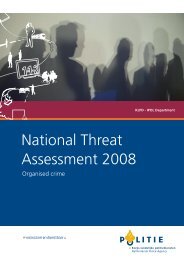Assessing the Effectiveness of Organized Crime Control Strategies ...
Assessing the Effectiveness of Organized Crime Control Strategies ...
Assessing the Effectiveness of Organized Crime Control Strategies ...
Create successful ePaper yourself
Turn your PDF publications into a flip-book with our unique Google optimized e-Paper software.
There have been a number <strong>of</strong> high-pr<strong>of</strong>ile seizures <strong>of</strong> property in Canada since <strong>the</strong> Proceeds <strong>of</strong><br />
<strong>Crime</strong> legislation was introduced. One <strong>of</strong> <strong>the</strong> largest resulted from a drug investigation<br />
involving <strong>the</strong> RCMP, Vancouver Police Department, and <strong>the</strong> US’ Drug Enforcement<br />
Administration. More than $15 million in property—primarily vessels and real estate—was<br />
seized in British Columbia and $57 million in property was seized in <strong>the</strong> US (Beare, 1997:122).<br />
From 1989-1993, Canadian police have seized assets <strong>of</strong> drug-related crimes totaling $72 million<br />
(Canadian Association <strong>of</strong> Chiefs <strong>of</strong> Police, 1993).<br />
Over <strong>the</strong> last 12 years, <strong>the</strong> Canadian government has implemented various strategies to combat<br />
money laundering and to confiscate <strong>the</strong> proceeds <strong>of</strong> crime. In 1992, <strong>the</strong> Integrated Anti-Drug<br />
Pr<strong>of</strong>iteering (IADP) initiative was introduced. Three multi-jurisdictional investigative units were<br />
established. Based in Canada’s three largest cities, <strong>the</strong>se units comprised <strong>the</strong> RCMP, provincial,<br />
and municipal police personnel, Department <strong>of</strong> Justice counsel, and forensic accountants from<br />
Revenue Canada-Customs. Annual evaluations indicated that <strong>the</strong> integrated approach improved<br />
drug-related investigations and prosecutions (Gabor, 1994); hence, <strong>the</strong> project was expanded to<br />
13 units that were now mandated to target a whole range <strong>of</strong> enterprise crimes (Department <strong>of</strong><br />
Justice Canada, 2000).<br />
No comprehensive, systematic evaluation <strong>of</strong> <strong>the</strong> forfeiture strategy has been undertaken. A<br />
Department <strong>of</strong> Justice Canada (2000:3) report indicates that, “Adequate information on resource<br />
utilization and costs, as well as long-term impacts on organized crime was not available.” The<br />
evidence that is available, however, suggests that proceeds <strong>of</strong> crime prosecutions tend to be<br />
complex and time consuming. Gibbon (1994), for example, reports on two cases in 1994 that<br />
took four years to develop.<br />
In <strong>the</strong> United States, forfeiture laws at <strong>the</strong> federal level have not been applied until quite recently.<br />
Between 1970 and 1980, <strong>the</strong> Rackateer Influenced Criminal Organization (RICO) and<br />
Continuing Criminal Enterprise (CCE) provisions were used in just 98 drug cases and assets<br />
forfeited amounted to only $2 million (Albanese, 1996:227). This record is poor when it is<br />
considered that more than 5,000 Class 1 violators were arrested by <strong>the</strong> Drug Enforcement<br />
Administration in that decade. These statutes were also designed to combat <strong>the</strong> infiltration <strong>of</strong><br />
legitimate businesses by OC; however, an audit by <strong>the</strong> General Accounting Office revealed no<br />
forfeiture <strong>of</strong> “significant derivative proceeds or business interests acquired with illicit funds”<br />
(Albanese, 1996:227).<br />
The <strong>Organized</strong> <strong>Crime</strong> Drug Enforcement Task Force Program (OCDETF) was established in<br />
1983 in <strong>the</strong> United States. The 13 task forces around <strong>the</strong> US involve 10 federal, as well as state<br />
and local agencies. In <strong>the</strong> first two years <strong>of</strong> operation, <strong>the</strong> task forces had seized $52 million in<br />
assets in cases involving 1,408 <strong>of</strong>fenders (Albanese, 1996:227). By <strong>the</strong> end <strong>of</strong> 1990, federal law<br />
enforcement agencies had seized $1.4 billion in cash and property. In 1991, <strong>the</strong> Drug<br />
Enforcement Administration seized property valued at $956 million (Bureau <strong>of</strong> Justice Statistics,<br />
1992). Also, in 1992, several states reported forfeitures that exceeded <strong>the</strong> seed money used to<br />
generate <strong>the</strong>m by ratios <strong>of</strong> 6:1 (Lyman and Potter, 1997:420).<br />
Notwithstanding <strong>the</strong>se and o<strong>the</strong>r enforcement efforts, <strong>the</strong> General Accounting Office asserts that<br />
<strong>the</strong>ir impact is unknown due to insufficient experience with <strong>the</strong> application <strong>of</strong> forfeiture laws<br />
Research and Statistics Division / Department <strong>of</strong> Justice Canada | 29








